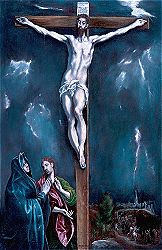His painting style was late Mannerism – “a term denoting the search for high style, often eccentric and dramatic. Centered in Italy, it filled the gap between the balance of high Renaissance and the Baroque.” [Dr Rudolph Wittkower, Art News] He was, perhaps, the greatest of the so-called “Mannerists,” [Suida], influenced by Titian, Tintoretto, & the Bassanos. He was called, after 200 years of neglect, “mad with genius, having unhealthy power and depraved energy” [Wittkower]. This was meant as praise, and critics continued to view him that way. Today, rather than “mad with genius,” he is seen as not only sane, but controlled by intellect, a great artist. In later years, El Greco collaborated with his son, Jorge Manuel, even going so far as to leave sketches for him and plans for future paintings after his own death. He always signed his paintings with his Greek birth name, Domenico Theotokopoulos, after a lifetime of being known as “El Greco.” SUBJECT: The dark background was derived from the New Testament, “God made it as night when Christ was crucified.” [Luke 23:44] In the distance we see a city – actually Toledo, but which might be interpreted as Jerusalem. The towers are elongated, and the buildings are outlined in white. PAINTING: Notice the hands! The gesture, so meaningful for El Greco, could be Christ’s blessing from the cross. El Greco typically used hand gestures in his paintings, and each had a definite, unalterable meaning for the artist. The pathetic gestures of Mary and St John emphasize the horror of the scene. In the Mannerist tradition, the fingers and limbs are elongated. Christ’s head, though, appears small. His style has been called “flamelike,” and earlier Renaissance work seems static when compared to El Greco. HISTORIC CONTEXT: The Catholic church and the Hapsburgs were Spain’s most important art patrons. Much of Spanish art is religious, intended to inspire pious thoughts and behavior in the viewer. In fact, Spain’s religious wars were what ruined her financially.
|
